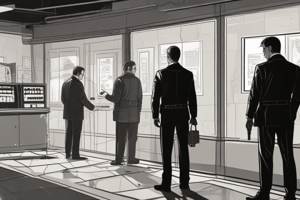Podcast
Questions and Answers
What type of evidence directly proves or disproves a fact?
What type of evidence directly proves or disproves a fact?
- Circumstantial Evidence
- Real Evidence
- Direct Evidence (correct)
- Demonstrative Evidence
What is the primary purpose of evidence in a legal case?
What is the primary purpose of evidence in a legal case?
- To draw conclusions or make inferences
- To support or confirm other evidence
- To prove or disprove a fact, guilt, or liability (correct)
- To provide context to the case
What characteristic of evidence refers to its trustworthiness and accuracy?
What characteristic of evidence refers to its trustworthiness and accuracy?
- Admissibility
- Reliability (correct)
- Sufficiency
- Relevance
What type of evidence may be influenced by personal opinions or biases?
What type of evidence may be influenced by personal opinions or biases?
What is the term for evidence that is used to illustrate or demonstrate a fact?
What is the term for evidence that is used to illustrate or demonstrate a fact?
What characteristic of evidence refers to whether it is strong enough to prove or disprove a fact?
What characteristic of evidence refers to whether it is strong enough to prove or disprove a fact?
What is the first step of Evidence-Based Practice (EBP)?
What is the first step of Evidence-Based Practice (EBP)?
Which step of Evidence-Based Practice involves searching for relevant clinical articles and evidence?
Which step of Evidence-Based Practice involves searching for relevant clinical articles and evidence?
What does the step 'critically appraise the evidence' entail in Evidence-Based Practice?
What does the step 'critically appraise the evidence' entail in Evidence-Based Practice?
Which step follows 'critically appraise the evidence' in the EBP process?
Which step follows 'critically appraise the evidence' in the EBP process?
What is the final step in the Evidence-Based Practice process?
What is the final step in the Evidence-Based Practice process?
Flashcards are hidden until you start studying
Study Notes
Types of Evidence
- Direct Evidence: Directly proves or disproves a fact, e.g., eyewitness testimony, video footage, or a confession.
- Circumstantial Evidence: Indirectly proves or disproves a fact, e.g., fingerprints, DNA, or suspicious behavior.
- Real Evidence: Physical objects or items related to the case, e.g., weapons, clothing, or documents.
- Demonstrative Evidence: Used to illustrate or demonstrate a fact, e.g., diagrams, charts, or models.
- Hearsay Evidence: Statements made by someone other than the witness, e.g., rumors, gossip, or second-hand information.
Characteristics of Good Evidence
- Relevance: The evidence must be related to the issue at hand.
- Reliability: The evidence must be trustworthy and accurate.
- Admissibility: The evidence must be allowed in court, following rules of evidence.
- Sufficiency: The evidence must be strong enough to prove or disprove a fact.
Roles of Evidence
- Proof: Evidence is used to prove or disprove a fact, guilt, or liability.
- Inference: Evidence is used to draw conclusions or make inferences.
- Corroboration: Evidence is used to support or confirm other evidence.
Limitations of Evidence
- Bias: Evidence may be influenced by personal opinions or biases.
- Inaccuracy: Evidence may be incorrect or incomplete.
- Context: Evidence may be taken out of context or misinterpreted.
- Availability: Evidence may be unavailable or inaccessible.
Types of Evidence
- Direct Evidence: Direct proof of a fact, such as eyewitness testimony, video footage, or a confession.
- Circumstantial Evidence: Indirect proof of a fact, such as fingerprints, DNA, or suspicious behavior.
- Real Evidence: Physical objects or items related to the case, like weapons, clothing, or documents.
- Demonstrative Evidence: Visual aids used to illustrate or demonstrate a fact, such as diagrams, charts, or models.
- Hearsay Evidence: Statements made by someone other than the witness, like rumors, gossip, or second-hand information.
Characteristics of Good Evidence
- Relevance: Evidence must be related to the issue at hand.
- Reliability: Evidence must be trustworthy and accurate.
- Admissibility: Evidence must be allowed in court, following rules of evidence.
- Sufficiency: Evidence must be strong enough to prove or disprove a fact.
Roles of Evidence
- Proof: Evidence used to prove or disprove a fact, guilt, or liability.
- Inference: Evidence used to draw conclusions or make inferences.
- Corroboration: Evidence used to support or confirm other evidence.
Limitations of Evidence
- Bias: Evidence may be influenced by personal opinions or biases.
- Inaccuracy: Evidence may be incorrect or incomplete.
- Context: Evidence may be taken out of context or misinterpreted.
- Availability: Evidence may be unavailable or inaccessible.
Steps of EBP
- The first step of EBP is to identify and formulate a clear review question
- The second step involves searching the literature for relevant clinical articles and evidence
- Critical appraisal of the evidence is the third step of EBP
- The fourth step of EBP is to implement the evidence within practice
- The final step of EBP is to evaluate the impact of the evidence
Goals of EBP
- No goals of EBP are specified in the given text
Studying That Suits You
Use AI to generate personalized quizzes and flashcards to suit your learning preferences.




